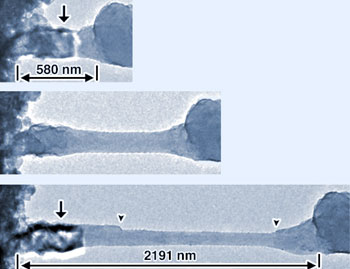미국의 과학자들에 의해서 원자들과 나노스케일 시스템을 연결할 수 있는 새로운 방법이 제안되었다. 만약 이 기술이 실험적으로 검증되면 포획된 원자들과 나노포토닉 디바이스를 연결시키는 방법으로 사용될 수 있을 것이다. 이 연구를 수행한 칼텍의 다릭 창(Darrick Chang)은 단지 수 나노미터 크기의 영역안의 금속 나노팁 근처에서 단일 원자를 포획할 수 있는 방법을 제안하였다고 말하였다. 이 포획된 원자들은 수십 나노미터 근처의 다른 표면으로 가져갈 수도 있다.

이 기술은 포획된 원자들이 마이크로 또는 나노 포토닉 디바이스와 같은 나노시스템 또는 대전되거나 자화된 양자 시스템에 직접적으로 결합되는 것을 가능하게 해준다. 이 원자는 또한 나노팁 표면을 따라 가이드된 광학 파장을 이용하여 매우 효율적으로 조작되거나 관측될 수 있을 것이라고 연구진은 말하였다.
이 방법은 빛이 원자들을 편극시키거나 쌍극자 모멘트를 발생시킬 수 있다는 원리에 기반한 원자 포획 기술에 기반하고 있다. 이런 원자 편극에 연관된 에너지는 상황에 따라 빛이 가장 강하거나 약한 곳으로 원자들이 움직일 때 최소화된다. 연구진은 레이저빔을 피뢰침(lightning rod) 역할을 하는 뾰쪽한 금속 나노팁에 조사하였다. 이 피뢰침은 레이저 빔의 세기를 크게 향상시키고 나노팁 근처에서 레이저빔 세기를 크게 변화시킨다.
실제로 나노팁 근처에 원자들을 포획할 수 있는 작은 영역이 있다고 연구진은 말하였다. 피뢰침은 트랩을 굳건하고 단단하게 만들어 나노팁을 다른 표면에 가져가도 트랩이 지속될 수 있게 한다고 연구진은 설명하였다. 이 기술은 광결정 공동이나 마이크로링 공진기같은 디바이스 근처의 원자들을 포획하는데 사용될 수 있을 것이다. 현재까지 이런 시스템 근처에서 원자들을 포획할 수 있는 방법을 개발하는 것은 어려운 문제였다고 연구진은 말하였다.
원자 포획에 사용하는 것을 포함한 또 다른 응용으로써는 높은 공간 분해능으로 표면 근처의 미약한 자기장을 검출하는 것이라고 연구진은 말하였다. 이와 같은 시스템은 원자들간의 짧은 거리로 매우 큰 상호작용이 가능한 새로운 다체 물리를 연구하는데 사용될 수 있을 것이다.
연구진은 현재 나노팁 근처에서 원자를 포획하는 실험을 준비 중이다. 연구진은 실험을 통하여 예측된 원자의 나노스케일 속박을 관측하고 나노팁을 따라 전파되는 표면 플라즈몬과 원자 사이의 효율적인 광학 결합도 관측할 수 있기를 희망하고 있다. 연구진은 실험이 성공적으로 수행되면 여러 응용 디바이스가 개발될 수 있을 것으로 내다보고 있다.
090517.jpg
http://nanotechweb.org/
-----------------------------------------------------------------------------------
Nanoscale plasmons trap atoms
A new way to interface atoms with nanoscale systems has been proposed by researchers in the US. The technique, if realized experimentally, could be used to connect trapped atoms with nanophotonic devices.

Trapping an atom
"We have proposed a method that should allow a single atom to be trapped near a metallic nanotip within a region just a few nanometres in size," team member Darrick Chang of Caltech told nanotechweb.org. "And this trapped atom can be brought to within tens of nanometres of other surfaces."
Trapping an atomThe technique could allow a trapped atom to be directly coupled to nanosystems, such as micro and nano-photonic devices, or charged or magnetized quantum systems. The atom could also be optically detected or manipulated with high efficiency using optical waves (surface plasmons) guided along the nanotip surface, says Chang.
The method is based on a common trapping technique for atoms that relies on the fact that light causes atoms to polarize or acquire a dipole moment. The energy associated with this atomic polarization is minimized when the atom moves to a region where the light field is weakest or strongest, depending on the conditions. Chang and colleagues use a laser beam to illuminate a sharp metallic nanotip that acts as a "lightning rod", which strongly enhances the laser field and causes large field variations near the end of the tip.
Vanishing field
"In fact, there is a small region near the tip where the variations cause the field to nearly vanish and where atoms can be trapped," explained Chang. "The lightning rod effect makes the trap tight and robust, which means that the trap persists even when the nanotip is brought close to other surfaces."
The technique could be used to trap individual atoms near devices like photonic crystal cavities or micro-toroidal resonators for realizing strong interactions between the atom and single photons confined in these devices. Until now, methods to trap atoms near such systems have remained elusive, says Chang.
Other applications include using the trapped atoms to detect weak magnetic fields near a surface with high spatial resolution. "More ambitiously, such a system might be exploited to explore novel many-body physics, where the small distances between atoms enable very large interactions between them."
advertisement
The team is now setting up an experiment to trap an atom near a nanotip. Initially, the researchers hope to observe the predicted nanoscale confinement of the atom as well as efficient optical coupling between the atom and guided surface plasmons propagating along the nanotip – relatively unexplored territory for trapped atoms. "If this is successful, we will then develop some of the applications mentioned above," said Chang.
The work was reported in arXiv.












